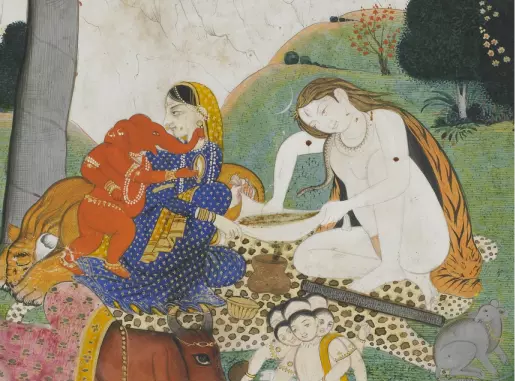India is the second-most populous country in the world with a population of 1.366 billion, and is the most populous democracy. In today’s global landscape, the country is a major international player, economically it is worth $2.7 trillion, making it the world’s sixth-largest economy. It is also incredibly religiously diverse with Hinduism, Buddhism, Sikhism, Islam, Christianity, and Jainism among the nation’s major religions. As impressive as their present standing is, their history is equally so. Indian cultural history spans more than 4,500 years making for a rich tapestry of myth, legend, and fact. This article is a deep dive into one aspect of that history – cannabis.
The First Record
The earliest mention of cannabis in India is found in the Vedas, composed in Sanskrit. The Vedas, meaning “knowledge”, are the oldest and most sacred texts of Hinduism – compiled as early as 1400 to 2000 B.C. According to these texts, cannabis was one of five sacred plants. It calls the plant a source of happiness that was compassionately given to humans to help us shed fear and attain delight.
Shiva and Cannabis
The Vedas also narrate a strong connection between the Indian deity Shiva and cannabis. Sociologist Theodore M. Godlaski recounts a popular myth around the God’s fascination with cannabis:
“When the Gods stirred the heavenly ocean with the peak of mount Mandara, a drop of amrita (sacred nectar) fell from the sky. Where it landed, the first cannabis plant sprouted. Lord Shiva brought the plant down from Mount Mandara for the benefit of mankind.”
This story has become so synonymous with cannabis use, you can’t mention one without the other.
For centuries, worshipers of Shiva have partaken in cannabis use in order to feel closer to their deity. A cannabis variant called bhang is frequently consumed and offered as part of festivities celebrating the god.
Bhang is an edible preparation made from the leaves of the cannabis plant. It has been used in food and drink as early as 1000 B.C. in ancient India.
Made using mortar and pestle, the leaves of the cannabis plant are ground into a paste. This paste is then added to food or drink. When preparing a beverage, it is generally mixed with milk and filtered. It is then flavored with kusha grass, sugar, fruit, and various spices for taste. This preparation is often used during festivals by Shiva devotees.
Bhang has been referenced in numerous ancient Indian texts dating back thousands of years, today it remains one of the only legal uses of cannabis in India.
Medicinal Uses of Cannabis in Ancient India
Shiva’s use of cannabis also extended to the medicinal.
One myth tells of the Samudra Manthana (Sanskrit: churning of the ocean of milk) – one of the best-known tales in the Hindu mythology. The Samudra Manthana explains the origin of Amrita and Shiva is a key character.
In it, a mythological poison called Halahala is released from the depths of the ocean, threatening all of existence. To save the universe, Shiva hurriedly drinks the poison only to be saved by his wife who chokes him to stop the poison from reaching his stomach.
Following the ordeal, Shiva’s wife Parvati gives him Bhang to soothe his throat.
The earliest mention of Bhang in a medicinal context outside of legend is in the works of Sushruta, believed to have been written between 500-600 A.D.
Sushruta was an ancient Indian physician and surgeon who shared his knowledge in textual form as the Sushruta Samhita. In the Sushruta Samhita, cannabis is described as “anti-phlegmatic” and is recommended as a remedy for diarrhea and biliary fever.
Bhang itself is one of three therapeutic parts of the cannabis plant used in Ayurveda, the world’s oldest health system. Bhang is a name for the leaves of male and female plants, and in certain regions of India the name is also used for flowers of the male plant. The name ganja is given to the flowering tops of the female plant, and charas is the name for the plant resin, which naturally exudes from leaves, stems and fruits of plants that grow in the mountains between 2000 and 3000 m of altitude. Ayurveda differentiates between these three therapeutic parts of the plant, and each one has a different action on the body. The use of cannabis alters three basic forces which govern the body and mind: vata, pitta and kapha. If one of these forces becomes unbalanced, the person may suffer from digestive problems, depression, lack of sex drive and tiredness. It would seem this traditional medicine has been aware for centuries of many of the facts that are being demonstrated in current scientific studies.
In Conclusion
Cannabis is an incredibly versatile plant. Used extensively across the ancient world, its medicinal, recreational, and religious significance cannot be understated.
Ancient India has a particularly interesting relationship with cannabis. From ancient Hindu texts to groundbreaking medicinal works, cannabis features often and in a variety of contexts. At present, India’s relationship with cannabis is a fraught one, but looking to the past proves just how important this plant can be in the future.
© Kanab Inc. – Kanab Inc. is a Toronto based cannabis retail company that honors the historical significance and uses of the cannabis plant across cultures and civilizations. Kanab has now opened its first cannabis dispensary at the intersection of Don Mills Road and York Mills Road in North York region of Toronto, Ontario (South of 401, West of 404 / Don Valley Parkway, and East of Leslie). For more info, please visit: kanab.ca






